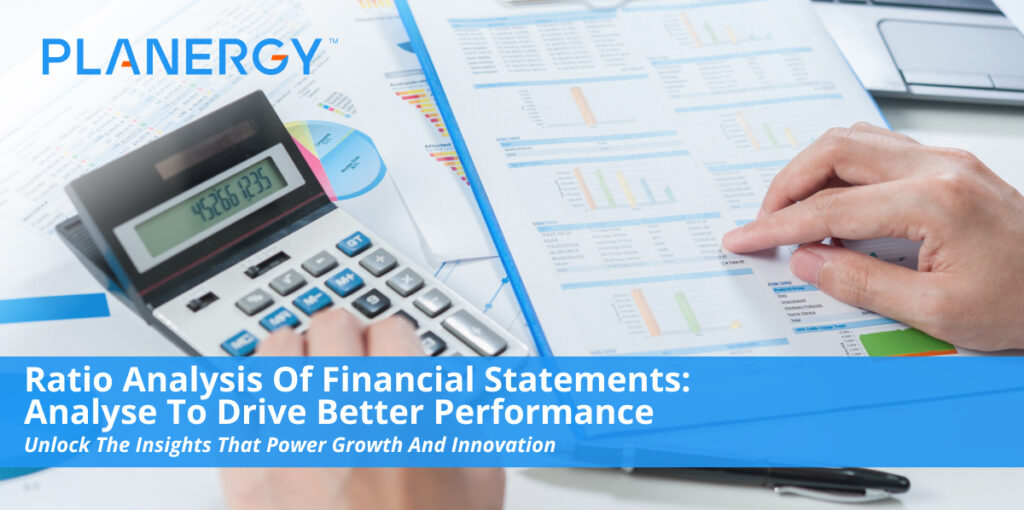Whether you’re an executive evaluating your company’s performance or an investor examining the financial health of your investments, a business’ financial statements hold a trove of useful insights. Data management tools such as ratio analysis help unlock those insights to provide not only a deeper understanding of a company’s performance, but guidance in crafting strategies that improve it.
With a clear understanding of why companies use ratio analysis of financial statements and the various types of analysis you can use to evaluate business performance, you’ll be well equipped to make better business decisions and strategize for greater value through process optimization, growth, innovation, and improved competitive strength.
What is Ratio Analysis of Financial Statements?
A company’s financial statements are more than just records of the business activities they’ve conducted for a given period of time. The financial information contained within a company’s balance sheet, income statement, and cash flow statement is used by analysts both internal (e.g., business managers) and external (e.g., investors and creditors) to evaluate a company’s overall status in various areas.
To do so, they rely on financial ratios, or comparisons of different financial relationships present in the financial statements. These relationships are used to examine the company’s performance in six areas:
- Liquidity
- Solvency
- Efficiency
- Coverage
- Profitability
- Market value
These comparisons can help internal and external stakeholders track performance over time and make adjustments to their policies and practices to improve it. They can be used to compare current performance to historic data, but are also used to compare the company’s performance in one or more areas against peers and competitors in the same industry, to the same ratio for companies in other industries, or for a given business sector.
In addition, ratio analysis can help establish trend lines, or ongoing financial patterns that can be used to improve forecasting or target and mitigate potential disruptions that might not be apparent with an analysis performed for any single reporting period.
Finally, ratio analysis is also useful in determining the efficiency of a company’s business operations. These analyses can measure efficient usage of both physical and financial assets, and help identify areas where the company is overextended financially or failing to use available resources effectively.
The financial information contained within a company’s balance sheet, income statement, and cash flow statement is used by analysts both internal (e.g., business managers) and external (e.g., investors and creditors) to evaluate a company’s overall status in various areas.
How Financial Ratio Analysis Works
While you can glean a certain amount of information from examining a company’s financial statements, deeper analysis is required to get the big picture and develop strategies for growth and performance improvement.
Ratio analyses are generally conducted quarterly and annually. Their utility and value lies not in any one single ratio, but in the context and clarity provided by conducting a full range of analyses and comparing them to:
- Historical financial information.
- Current information for other companies in the same industry, business sector, etc.
- The same ratio as applied in different industries or business sectors.
It’s in these comparisons that the true value of ratio analysis is found for both internal and external stakeholders. Think of it as the difference between looking at one small part of a map, or having the whole thing spread out on the table. The more context and visibility you have, the more effectively you can evaluate what you’re seeing—and act appropriately.
While ratio analysis of financial statements is theoretically as simple as collecting the necessary documents and performing basic calculations, investing in a cloud-based, centralized data management solution like PLANERGY is a smart move for any business interested in making optimal use of financial ratio analysis.
Process automation and powerful analysis and reporting tools—all powered by advanced artificial intelligence—provide clean, complete data and the ability to analyze it with optimal efficiency for truly actionable insights, as well as forecasting and business strategy tools for putting the insights to work.
Types of Ratio Analysis
Each of the six main financial ratios contain a subset of specific analyses used to explore and improve different aspects of the ratio.
Liquidity Ratios
These ratios are used to determine business business liquidity, i.e., whether a company can meet its current liabilities (debt obligations) with the current assets it has available.
Three important liquidity ratios are:
- The Working Capital Ratio is calculated by deducting current liabilities from current assets as listed on the company’s balance sheet. Also known as the current ratio, the working capital ratio is a straightforward yardstick for determining whether a company’s current assets can cover its short-term debts.
- The Quick Ratio also relies on figures from the balance sheet, but deducts the quotient of the company’s current inventory divided by its current liabilities rather than current liabilities alone (i.e., current assets – (inventory ÷ current liabilities)). Also called the acid test ratio, it’s used to determine whether the company can cover its short-term debts without selling any inventory.
- The Cash Ratio provides a narrower, cash-based picture of liquidity. It divides current assets over current liabilities, but considers only cash and cash equivalents (such as money market accounts, savings accounts, etc.) as assets (i.e., (cash + cash equivalents) ÷ current liabilities). This ratio is more conservative than the other two liquidity ratios and is used to measure a company’s ability to pay off all current liabilities without liquidating additional assets.
Solvency Ratios
Also called debt management ratios, solvency ratios are used to provide financial managers with a clear picture of how well the company is financing operations with regard to debt management (i.e., financial leverage). These ratios measure the amount of debt used by the firm in comparison to its equity financing or retained earnings.
Two of the most important solvency ratios are:
- The Total Debt Ratio is calculated by dividing current liabilities over total assets (i.e., total liabilities ÷ total assets). It’s expressed as a percentage and used to determine how much of the company’s current assets are financed by debt.
- The Debt-to-Equity Ratio is one of the most critical for any publicly traded organization. It is very similar to the Total Debt Ratio, but is calculated by dividing total liabilities over shareholders’ equity (i.e., total liabilities ÷ (total assets-total liabilities)). This ratio provides a useful thumbnail of financial health for investors and governing bodies and helps indicate whether a company’s capital structure is focused on financing via debt or equity.
Efficiency Ratios
Stakeholders and analysts use these ratios to measure how well a company is leveraging both assets and liabilities to create sales and turn a profit. Also referred to as activity ratios, return on asset ratios or asset management ratios, they’re crucial in determining and improving performance because finding ways to improve them correlates to a direct improvement in revenue and profitability.
Four of the most commonly used efficiency ratios are:
- The Inventory Turnover Ratio compares sales to inventory (i.e., sales ÷ inventory) to determine how often inventory is sold and replaced (i.e., turned over) each year. It’s useful in determining whether the company’s holding on to costly dead inventory for too long or using it cost-effectively.
- The Days Sales Outstanding Ratio is used to measure the company’s efficiency in collecting outstanding credit accounts. It’s calculated by dividing accounts receivable (AR) by average daily sales (ADS) (i.e., AR ÷ ADS).
- The Fixed Assets Turnover Ratio measures how well a company uses its fixed assets, e.g. plant facilities, manufacturing equipment, property, etc. It’s calculated as sales ÷ net fixed assets.
- The Total Assets Turnover Ratio is calculated as sales ÷ total assets. It’s similar to the Fixed Assets Turnover Ratio, but is used to determine how well the company is leveraging its assets to create revenue and drive profitability.
Interest Coverage Ratios
These ratios are used to determine how well a company can cover both its outstanding debts and the related costs of taking on the debt. Interest payments, dividends, and lease payments are some of the most common debts evaluated using these ratios. Generally speaking, a higher coverage ratio is better than a lower one, as it indicates greater ability to meet financial obligations.
Three of the most commonly used interest coverage ratios are:
- The Times Interest Earned Ratio divides earnings before interest and taxes (EBIT) by its interest expenses (i.e.,, EBIT ÷ interest expenses) to determine how well a company can cover its total debt and/or the interest payments on that debt.
- The Debt Service Coverage Ratio (DSCR) is calculated as net operating income ÷ total debt service charges. It provides a quick reference on how well the company can meet its debt service obligations (i.e., the amount of cash required to cover both the principal and interest on a loan for a given time period).
- The Dividend Yield Ratio is expressed as dividend ÷ stock price. It measures the total amount paid in dividends by a company relative to the price of its stock. Investors often look at the dividend yield ratio as a metric for organizational maturity and longevity, as mature companies often have higher dividend yields than smaller or younger businesses in the same industry.
Profitability Ratios
Summarizing the impact of liquidity, solvency, efficiency, and coverage ratios, profitability ratios provide deeper context for analysts and stakeholders in evaluating the financial performance and health of a business.
Four of the most critical and commonly used profitability ratios are:
- The Net Profit Margin Ratio is net income ÷ sales and measures how much profit is generated for the company for every dollar of sales revenue.
- The Return on Total Assets Ratio (ROA) is net income ÷ total assets. It measures how efficiently the company’s assets generate a profit.
- The Basic Earning Power Ratio (BEP) is EBIT ÷ total assets. It’s similar to the ROA, but provides crucial context by removing debt and taxes from the calculation.
- The Return on Equity Ratio (ROE) is net income ÷ common equity. This ratio measures the return earned by investors. As with the debt-to-equity ratio, this ratio is crucial for publicly traded companies in particular, and performance equal to or just above one’s peers makes a business more attractive to investors.
Market Value Ratios
They’re not used very often by small businesses or freelance firms, but market value ratios are essential for publicly traded firms or any business that hopes to attract investors with the promise of a strong return.
Three of the most important market value ratios are:
- The Price/Earnings Ratio (P/E) is stock price per share ÷ earnings per share. The P/E ratio indicates how much investors are willing to pay for company stock per dollar of profits generated.
- The Price/CashFlow Ratio is stock price ÷ cash flow per share. A healthy cash flow is essential to operating and growing a business, so investors pay close attention to this ratio.
- The Market/Book Ratio is stock price ÷ book value per share. Used to compare a company’s stock price to the market value, this ratio can be a reliable indicator of whether a stock is likely to increase in value over time (particularly for undervalued stocks).
Making Optimal Use of Your Financial Statement Analysis
While it provides invaluable insights via convenient distillations of financial information, it’s important to keep in mind the limitations of financial ratio analysis as well as its benefits.
|
BENEFITS |
LIMITATIONS |
| Provides useful insights in setting performance goals. | Large international companies must break out ratios by divisions rather than for the organization as a whole. |
| Useful in evaluating performance over time and identifying trends. | Some companies may “fudge the numbers” to appear more attractive to investors during valuation. |
| Useful in evaluating and contextualizing performance as compared to competitors, industry standards, and peers in other industries/business sectors. | Not useful for seasonal and cyclical businesses, as ratios will be distorted by peaks and valleys over time. (e.g., a Christmas shop’s Q4 ratios will be radically different than its Q2 ratios). |
| Best for smaller businesses or individual divisions/business units within larger organizations. | Inflation or economic instability can skew results and limit the utility of both period-specific ratios and comparisons to historic performance. |
Grow, Thrive, and Optimize with Financial Ratio Analysis
Knowing how well your company’s doing is essential to crafting strategies that’ll help it do even better—and a crucial part of keeping investors and other external shareholders informed about and engaged with your company’s success.
When you leverage ratios effectively, you can transform the data from your financial statements into actionable insights about your company’s performance. And by understanding its capabilities and limitations, you can make smart decisions that’ll help you optimize your workflows for efficiency, savings, and value while strengthening your competitive performance and profitability.




